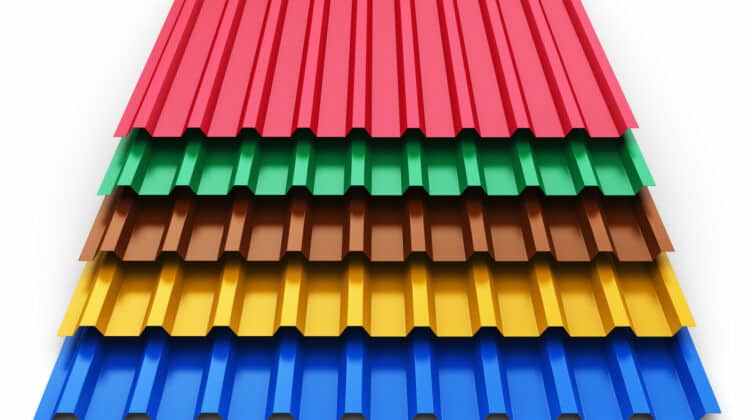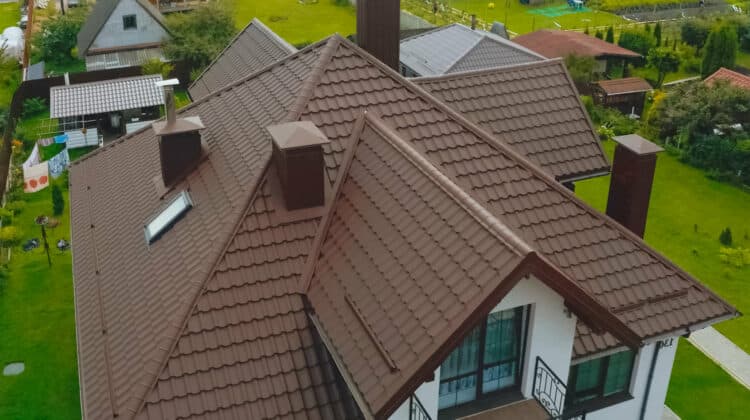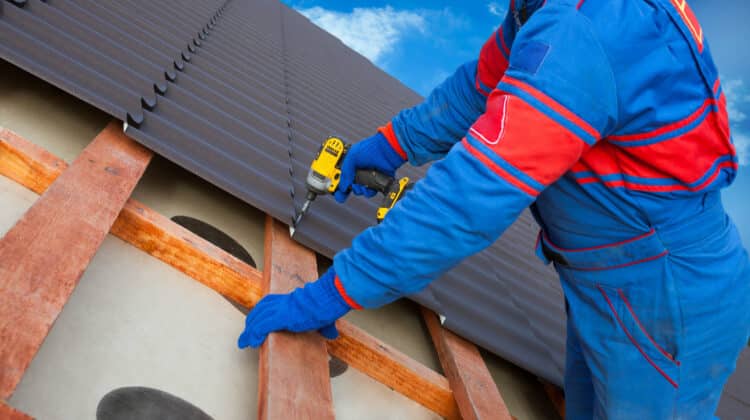Are you planning to build a home and faced with this question: how many sheets of metal roofing do I need?
There are many ways to measure the amount of metal roofing, which will depend on the style of your roof and how big it is. You will need to do this before going ahead in constructing your home.
However, if you have never tried to do this task before and your home has unique specifications, it might be better to hire a professional roofer to get an estimation of how many metal panels to buy.
If you have a simpler and symmetrical style of home, you can do the measurements yourself with these simple steps below:
Table of Contents
How shall I learn how many sheets of metal roofing do I need?
Here is the best and most efficient way to know how many metal sheets you need for your roof:
Measuring your roof
To get a correct estimate on how many metal roofing panels you need, you have to measure your roof.
You will need a measuring tape to measure the distance from one outside edge to the opposite outer edge of the roof. You will get its length and width from the measurements, which you will need to write down on a piece of paper.
Knowing the specifics of your metal sheets
Not every type of metal sheet has the same width and height. Before buying your preferred one, ask the supplier first for those details. After getting them, you can divide the width of the sheet by the length of the roof.
For instance, your roof is measured two-hundred forty inches wide, and the metal panels have a width of twenty-four inches, dividing two-hundred forty by twenty-four. The result is ten, which is the number of metal sheets you will need to cover the whole roof.
Do not presume that all sides of the roof have the same measurements
Some roofs do not have exact measurements on all sides, so before installing the metal panels on your roof, it is practical to measure them again. This way, you can still adjust the metal sheets before installing them.
Determining how long the metal panels have to be
Once you have established how many metal panels you need, you will have to determine how long they should be. You will need the prior measurements you got from the sides of the roof since the base and the peak may be measured differently.
If your preference is for the metal sheets to have a slight overhang, add one to two inches from the prior measurement.
Consulting with a professional roofer
As mentioned, if you are unsure about getting the right measurements on your roof, consult or hire a professional. This way, you will get the exact amount of metal sheets you will need and not overspend.
Helpful tips in getting the proper amount of metal panels for your roof
- Make sure you order ten percent more metal panels from the roofing supplier to allow for calculation errors and accidental damage. Professional builders and roofers follow this standard safety margin, which they apply in getting all kinds of materials for home construction.
- If you are uncertain about overlapping sheets or any other roofing issue, consult with a roofing expert. This way, you will know all the pertinent information like climate issues that can impact the size of the overlap and many more.
- Some situations occur (like reroofing historic buildings) when you need to consult your local regulations before installing a new roof.
How to install metal roofing sheets
After knowing about your roof’s measurements and getting the right amount of metal panels, you will need to install them on your roof.
Tools and materials you need to know how many metal sheets your roof requires
- Basic tools for carpentry
- Metal shears
- Aviation snips
- Driver/drill
- Hand seamer
- Fall protection
- Metal roofing sheets
- Roofing nails
- Water and ice shield
- Eave and gable trim
- Ridge cap
- Sidewall flashing
- roofing vent boots
- Butyl tape
- Outside and inside foam closure strips
- Self tapping roofing screws
Applying the underlayment to your roof
The first step is to apply the underlayment, which serves as a protective covering against sunlight, water, wind, and other debris.
You can choose from either TPO (Thermoplastic Polyolefin) or EPDM (Ethylene Propylene Diene Monomer).
Unroll it across the roof and make sure to remove the adhesive backing to stick. Overlap each roll by six to eight inches and is free of wrinkles.
Pre-order the metal sheets to fit your roof
Make sure you have measured the roof before so you can order the panels already in the proper sizes. You can carry them one by one in the room or hire a large lift to hoist all of them on top of the roof.
Bend the ends of the trim closed
Before installing the trim, cut the leading end and bend it. It will wrap itself around the corner.
Use aviation snips to make one-inch cuts at each bend to make tabs. Then use a hand seamer to fold them in so it can connect to a corner or wall.
Each trim will be a different shape, thus each cut and bend is unique.
Fastening the eave trim
Fasten tightly the eve trim to the fascia, then install it to the roof deck over the membrane with roofing nails. It serves as additional protection from weather elements.
Splicing and overlapping the trims
Whenever two trim edges meet, you will have to splice them together.
Cut the at an angle the bottom hem the overlapping trim, and after fastening the underlapping trim, put an adhesive sealant on top.
Open forcefully the bottom hem of the overlapping trim and slowly slip over the hem that was cut at an angle of the underlapping trim.
Snapping a square reference line
A square reference line is essential for evenly installing the roofing sheets.
Make a three-foot mark by the eave, then measure four feet towards the ridge.
Measure five feet from the original corner and make a where it crosses the second mark.
Snap a line from the first mark measuring three feet via the intersection of the second and third markings. You will get the square reference line by multiplying the three measurements by seven.
Positioning the metal sheets
Position each metal sheet within the confines of the inside foam closure strip, which is shaped to fit them.
Set the closure strips along the eaves about an inch from the edges and stick them with butyl tape.
Apply sealant on top of the strip, and lay down the sheets they can overhang about an inch from the eaves.
Driving the screws in
To keep the metal sheets watertight, line up the screws on both sides of every rib so they can go through the foam strips.
Begin at the bottom, screwing the sheets in rows and going in the direction of the ridge.
Do not overtighten the screws since you have to compress the rubber gasket to the screw head.
Overlapping the panels
Each edge of the metal sheet is different, and make sure to overlap it to fit with each other.
Covering the rake edge
Attach the gable trim after all the sheets are fastened securely. It will keep the rain and snow from going below the panels and siding.
Securing the ridge cap
Lastly, apply adhesive sealant on the foam closure to secure the ridge cap.
Once your roof is capped successfully, this will ensure your roof is well protected from the weather elements.
What are the most popular metal roofing materials?
There are five of the most common metal roofing materials for your roof, including their pros and cons:
Aluminum roofing
Pros of aluminum roofing
- Lightweight
- Corrosion-resistant
- Malleable
Cons of aluminum roofing
- Prone to denting
- Expensive
- Less color alternatives and availability
Copper roofing
Pros of copper roofing
- Lightweight
- Long-lasting
- Appealing
- Corrosion-resistant
- Easy to install
Cons of copper roofing
- Prone to denting
- Expensive
- Less availability
Steel roofing
Pros of steel roofing
- Fire and rot resistant
- Low maintenance
- Durable
- Cost-effective
- Long-lasting
Cons of steel roofing
- Less resistant to corrosion
- Heavier
- Shorter lifespan compared to zinc, aluminum and copper
Tin roofing
Pros of tin roofing
- Easy to install
- lightweight
Cons of tin roofing
- No longer available and used
Zinc roofing
Pros of zinc roofing
- Appealing
- Long-lasting
- Corrosive-resistant
Cons of zinc roofing
- Chalking
- Limited availability
- Expensive
What are the types of metal roofing sheets?
- Corrugated metal roofing
- Standard seam roofing
- Metal shingle roofing
- Metal slate roofing
- Metal tile roofing
Does it matter how many sheets of metal roofing do I need to install on my roof?
It does, and getting the right amount of metal roofing sheets is crucial so you would not encounter any issues anymore when installing them on your roof.
If it is too much work, you can always hire a professional roofer.





